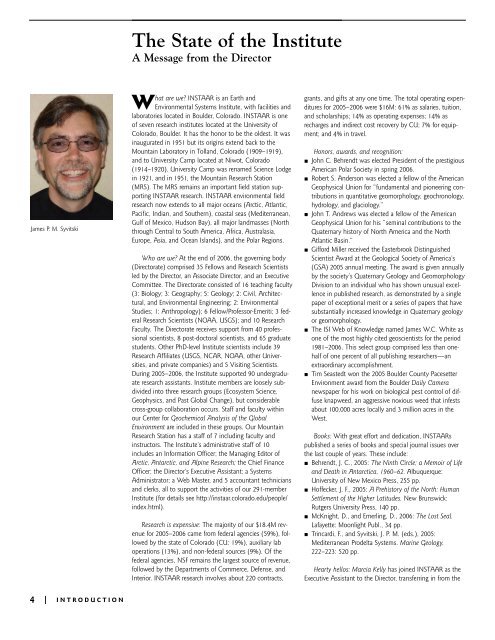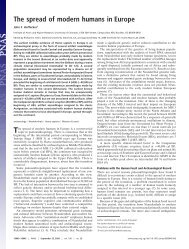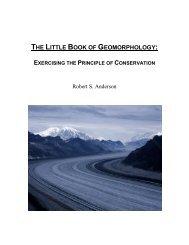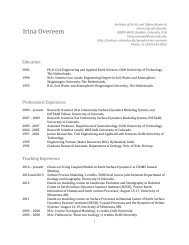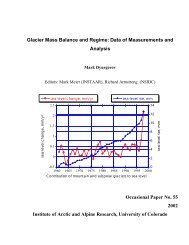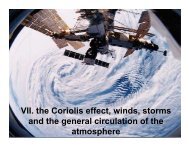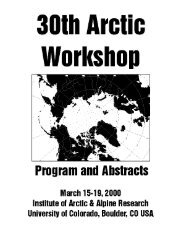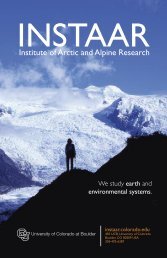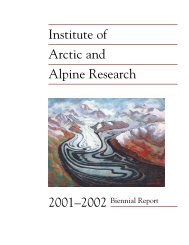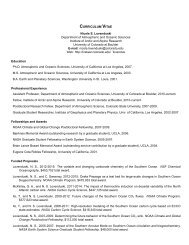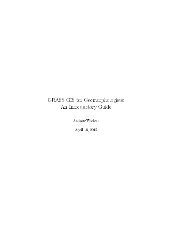00_cover_Biennial Report 05-06.qxd - INSTAAR - University of ...
00_cover_Biennial Report 05-06.qxd - INSTAAR - University of ...
00_cover_Biennial Report 05-06.qxd - INSTAAR - University of ...
- No tags were found...
Create successful ePaper yourself
Turn your PDF publications into a flip-book with our unique Google optimized e-Paper software.
The State <strong>of</strong> the InstituteA Message from the DirectorJames P. M. SyvitskiWhat are we? <strong>INSTAAR</strong> is an Earth andEnvironmental Systems Institute, with facilities andlaboratories located in Boulder, Colorado. <strong>INSTAAR</strong> is one<strong>of</strong> seven research institutes located at the <strong>University</strong> <strong>of</strong>Colorado, Boulder. It has the honor to be the oldest. It wasinaugurated in 1951 but its origins extend back to theMountain Laboratory in Tolland, Colorado (1909–1919),and to <strong>University</strong> Camp located at Niwot, Colorado(1914–1920). <strong>University</strong> Camp was renamed Science Lodgein 1921, and in 1951, the Mountain Research Station(MRS). The MRS remains an important field station supporting<strong>INSTAAR</strong> research. <strong>INSTAAR</strong> environmental fieldresearch now extends to all major oceans (Arctic, Atlantic,Pacific, Indian, and Southern), coastal seas (Mediterranean,Gulf <strong>of</strong> Mexico, Hudson Bay), all major landmasses (Norththrough Central to South America, Africa, Australasia,Europe, Asia, and Ocean Islands), and the Polar Regions.Who are we? At the end <strong>of</strong> 2<strong>00</strong>6, the governing body(Directorate) comprised 35 Fellows and Research Scientistsled by the Director, an Associate Director, and an ExecutiveCommittee. The Directorate consisted <strong>of</strong> 16 teaching faculty(3: Biology; 3: Geography; 5: Geology; 2: Civil, Architectural,and Environmental Engineering; 2: EnvironmentalStudies; 1: Anthropology); 6 Fellow/Pr<strong>of</strong>essor-Emeriti; 3 federalResearch Scientists (NOAA, USGS); and 10 ResearchFaculty. The Directorate receives support from 40 pr<strong>of</strong>essionalscientists, 8 post-doctoral scientists, and 65 graduatestudents. Other PhD-level Institute scientists include 39Research Affiliates (USGS, NCAR, NOAA, other Universities,and private companies) and 5 Visiting Scientists.During 2<strong>00</strong>5–2<strong>00</strong>6, the Institute supported 90 undergraduateresearch assistants. Institute members are loosely subdividedinto three research groups (Ecosystem Science,Geophysics, and Past Global Change), but considerablecross-group collaboration occurs. Staff and faculty withinour Center for Geochemical Analysis <strong>of</strong> the GlobalEnvironment are included in these groups. Our MountainResearch Station has a staff <strong>of</strong> 7 including faculty andinstructors. The Institute’s administrative staff <strong>of</strong> 10includes an Information Officer; the Managing Editor <strong>of</strong>Arctic, Antarctic, and Alpine Research; the Chief FinanceOfficer; the Director’s Executive Assistant; a SystemsAdministrator; a Web Master, and 5 accountant techniciansand clerks, all to support the activities <strong>of</strong> our 291-memberInstitute (for details see http://instaar.colorado.edu/people/index.html).Research is expensive: The majority <strong>of</strong> our $18.4M revenuefor 2<strong>00</strong>5–2<strong>00</strong>6 came from federal agencies (59%), followedby the state <strong>of</strong> Colorado (CU: 19%), auxiliary laboperations (13%), and non-federal sources (9%). Of thefederal agencies, NSF remains the largest source <strong>of</strong> revenue,followed by the Departments <strong>of</strong> Commerce, Defense, andInterior. <strong>INSTAAR</strong> research involves about 220 contracts,grants, and gifts at any one time. The total operating expendituresfor 2<strong>00</strong>5–2<strong>00</strong>6 were $16M: 61% as salaries, tuition,and scholarships; 14% as operating expenses; 14% asrecharges and indirect cost re<strong>cover</strong>y by CU; 7% for equipment;and 4% in travel.Honors, awards, and recognition: John C. Behrendt was elected President <strong>of</strong> the prestigiousAmerican Polar Society in spring 2<strong>00</strong>6. Robert S. Anderson was elected a fellow <strong>of</strong> the AmericanGeophysical Union for “fundamental and pioneering contributionsin quantitative geomorphology, geochronology,hydrology, and glaciology.” John T. Andrews was elected a fellow <strong>of</strong> the AmericanGeophysical Union for his “seminal contributions to theQuaternary history <strong>of</strong> North America and the NorthAtlantic Basin.” Gifford Miller received the Easterbrook DistinguishedScientist Award at the Geological Society <strong>of</strong> America’s(GSA) 2<strong>00</strong>5 annual meeting. The award is given annuallyby the society’s Quaternary Geology and GeomorphologyDivision to an individual who has shown unusual excellencein published research, as demonstrated by a singlepaper <strong>of</strong> exceptional merit or a series <strong>of</strong> papers that havesubstantially increased knowledge in Quaternary geologyor geomorphology. The ISI Web <strong>of</strong> Knowledge named James W.C. White asone <strong>of</strong> the most highly cited geoscientists for the period1981–2<strong>00</strong>6. This select group comprised less than onehalf<strong>of</strong> one percent <strong>of</strong> all publishing researchers—anextraordinary accomplishment. Tim Seastedt won the 2<strong>00</strong>5 Boulder County PacesetterEnvironment award from the Boulder Daily Cameranewspaper for his work on biological pest control <strong>of</strong> diffuseknapweed, an aggressive noxious weed that infestsabout 1<strong>00</strong>,<strong>00</strong>0 acres locally and 3 million acres in theWest.Books: With great effort and dedication, <strong>INSTAAR</strong>spublished a series <strong>of</strong> books and special journal issues overthe last couple <strong>of</strong> years. These include: Behrendt, J. C., 2<strong>00</strong>5: The Ninth Circle; a Memoir <strong>of</strong> Lifeand Death in Antarctica, 1960–62. Albuquerque:<strong>University</strong> <strong>of</strong> New Mexico Press, 255 pp. H<strong>of</strong>fecker, J. F., 2<strong>00</strong>5: A Prehistory <strong>of</strong> the North: HumanSettlement <strong>of</strong> the Higher Latitudes. New Brunswick:Rutgers <strong>University</strong> Press, 140 pp. McKnight, D., and Emerling, D., 2<strong>00</strong>6: The Lost Seal.Lafayette: Moonlight Publ., 34 pp. Trincardi, F., and Syvitski, J. P. M. (eds.), 2<strong>00</strong>5:Mediterranean Prodelta Systems. Marine Geology,222–223: 520 pp.Hearty hellos: Marcia Kelly has joined <strong>INSTAAR</strong> as theExecutive Assistant to the Director, transferring in from the4 | INTRODUCTION


